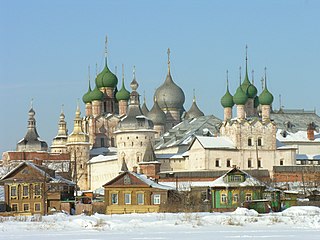
The oblast Yaroslavl (Russian: Ярославская область) located in Central Russia. It is located north of the region Moscow and borders the oblasts Tver, Vologda, Ivanovo, Vladimir and Kostroma.
Regions
&groups=Maske,Track,Aktivitaet,Anderes,Anreise,Ausgehen,Aussicht,Besiedelt,Fehler,Gebiet,Kaufen,Kueche,Sehenswert,Unterkunft,aquamarinblau,cosmos,gold,hellgruen,orange,pflaumenblau,rot,silber,violett)
The region around Yaroslavl is relatively flat, its altitude varies between 90 m and 180 m, it is about 40% forested. It is traversed by the Volgawhich has two barrages in this oblast. The first is the Uglitscher Reservoir that is 143 km long and up to 5 km wide. At the bottom of this lake is much of the old town of Kalyasin, an old bell tower still shows the location of the place today. The one created by the second barrage is much larger Rybinsker Reservoir, it is around 100 km long and up to 50 km wide. The area has no water shortage in other respects either, there are 83 lakes in total, the largest is the Nero-See at Rostov, there are also numerous moors in the flat country. About 40% of the land area is forested, the area is popular with hunters and anglers alike.
places
- 1 Yaroslavl
 is the capital of the area and has over 600,000 inhabitants
is the capital of the area and has over 600,000 inhabitants - 2 Rybinsk

- 3 Pereslavl-Zalessky

- 4 Rostov Veliky

- 5 Tutayev

- 6 Uglich

- 7 Myshkin

Other goals
- 1 Rybinsk Reservoir. By damming the rivers Volga, Scheksna and Mologa the 4,580 km² Rybinsk Reservoir was created, it is approx. 110 km long and up to 60 km wide. The locks in the dam are used for navigation on the Volga. The dammed water of the lake operates a power plant. When the lake was dammed, the city sank 2 Mologa in the floods, and it is said that around 300 people did not want to give up their homeland and drowned in the lake.
- 3 Uglich reservoir. The lake is approx. 140 km long and up to 5 km wide, it was created around 1940 when the Volga was dammed. The bell tower of the Nikolaikirche is worth seeing Kalyasin protrudes from the lake.
background
language
getting there
By plane
Yaroslavl Oblast is close enough to Moscow. Most visitors therefore arrive via the capital's international airports. By the city Yaroslavl there is the airport Tunoshnaserved by local companies.
In the street
The main thoroughfare M8going from Moscow to Chlmogory (Холмого́ры) leads at Arkhangelsk. From Yaroslavl there is also a trunk road to Kostroma.
By train
The northern route of the Trans-Siberian Railway runs through the city of Yaroslavl, there are a few branch lines.
By boat
During the summer months drive on the Volga and its tributaries river cruise ships.
mobility
Tourist Attractions
There are numerous churches, monasteries and Kremlin, as the Russian type of castles or citadels are called, in the Yaroslavl area. Part of it counts to Golden ring. During the time of the Russian Revolution, many art treasures were irretrievably lost, and a number of buildings fell victim to the damming of the Volga and its tributaries, but there are still a large number of sights here. They are easiest to find in the tourist centers, which already had a good infrastructure during the Soviet era, primarily these are Rostov and Yaroslavl.










